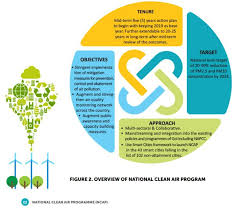
Status of National Clean Air Program
Status of National Clean Air Program
GS-3: Environment
(IAS/UPPCS)
Relevant for Prelims:
National Clean Air Programme, Particulate Matter Concentration, Central Pollution Control Board (CPCB), Ministry of Environment, Forest and Climate Change.
Relevant for Mains:
About National Clean Air Programme, features of the programme, issues and concerns, way forward.
26/04/2024
Source: TH
Why in news:
According to the recent government assessment, the National Clean Air Program could not achieve the target of reducing pollution by the year 2024.
- Persistent violations of PM levels by cities in India and inconsistent implementation of clean air action plans are hindering the success of the National Clean Air Programme.
About National Clean Air Programme:
- The program was launched by the Ministry of Environment, Forest and Climate Change in January 2019 as a comprehensive initiative in partnership with various ministries and states to improve air quality at city, regional and national levels.
Target:
- The program aims to improve air quality in 131 cities (non-attainment cities and million plus cities) across 24 states by involving all stakeholders.
Objectives:
- To achieve the target of 20-30% reduction in particulate matter concentrations by 2024 compared to the base year 2017. However, the target has been revised to achieve up to 40% reduction or National Ambient Air Quality Standards (NAAQS) in terms of PM concentrations by 2025-26.
- Strictly implement measures for prevention, control and mitigation of air pollution.
- Adoption of airshed approach to tackle air pollution.
- To coordinate with existing policies and programmes.
- Central Pollution Control Board (CPCB) issues guidelines regarding criteria for setting up air quality monitoring stations based on the population of a city/town.
Features of the programme:
- Under NCAP, cities in India that consistently violate annual PM levels are required to prepare and implement an Annual Clean Air Action Plan (CAAP).
- To facilitate this, the Ministry of Environment, Forest and Climate Change has allocated ₹10,422.73 crore.
- NCAP envisages a 20-30% reduction in PM10 concentration over the 2017 baseline by 2024.
- The target has been revised to achieve 40% reduction in PM10 levels or achievement of national standards (60 μg/m3) by 2025-26.
Issues and Concerns:
- One of the goals of NCAP is to establish an infrastructure for forecasting air quality, but none of the cities except Delhi, Pune, Mumbai and Ahmedabad have a decision-support system.
- Most cities proactively submitted their Clean Air Action Plans (CAAPs), yet their implementation has been inconsistent.
- According to the ministry, on average only 60% of the funds allocated have been utilized so far, with 27% of cities spending less than 30% of their earmarked budget.
- Delays in implementation hinder the success of NCAP, particularly delays in approvals from competent authorities (for example, technical specifications of tender processes or for procurement of products such as mechanical sweepers and electric buses).
- There is also a lack of standard operating procedures for the implementation process.
- Many existing control measures focus only on primary PM emissions, ignoring their secondary precursors.
- Further delays are caused by the time-consuming tasks required to implement control measures and the absence of well-defined timelines.
- Yet other reasons include bureaucratic red tape and lingering doubts about the effectiveness of proposed mitigation measures.
- Pollution from high-emitting industries and other sources outside city limits is carried by winds into urban areas, complicating urban air-quality management.
- According to the portal for regulation of air pollution in non-attainment cities, only 37% of cities have completed the EI&SA study, meaning the remaining 63% do not have clear information about what is polluting their air.
- Pollution from high-emitting industries and other sources outside city limits is carried by winds into urban areas, complicating urban air-quality management.
Government initiatives to achieve the target:
- The Central Pollution Control Board (CPCB) will implement a nationwide program for the prevention, control of air pollution in accordance with the Air (Prevention and Control of Pollution) Act, 1981 and specifically under Section 16(2)(B) of the Act.
- NCAP will be institutionalized by line ministries and implemented through inter-sectoral groups, in which, apart from the concerned ministries, Finance Ministry, Health Ministry, NITI Aayog, CPCB, industry, experts from academia and civil society are included.
Way forward:
- Cities should look at EI and SA data to identify air pollutants and design mitigation measures targeting each polluting activity.
- Based on capacity and infrastructure requirements, cities need to set appropriate annual targets and fund them.
- Beyond the need for data and models, rapid implementation on the ground is essential. To this end, implementing agencies should attempt to reduce bureaucratic red tape by using shared, standardized technical assessments.
- Estimates of technical feasibility, budget and time should be part of the preliminary plans.
- The success of NCAP depends on a multi-pronged approach that combines rigorous scientific studies, strategic funding and fast and effective implementation of mitigation measures.
---------------------------------------------------
Mains Question:
Discuss the way forward to address the issues and challenges related to the National Clean Air Programme.